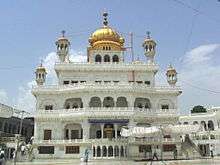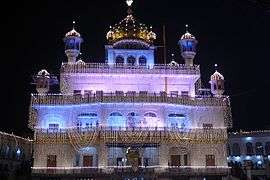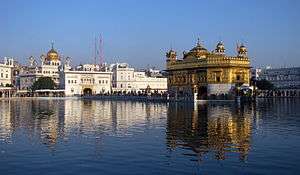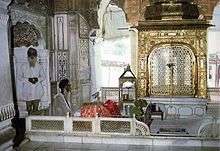Akal Takht
| Akal Takht | |
|---|---|
| ਅਕਾਲ ਤਖ਼ਤ | |
 | |
 Photograph of Akal Takht | |
| Alternative names | Akal Bunga |
| General information | |
| Status | First Takht of the Sikhs [1] |
| Architectural style | Sikh architecture |
| Address | Akal Takht, Golden Temple Rd, Atta Mandi, Katra Ahluwalia, Amritsar, Panjab |
| Town or city | Amritsar |
| Coordinates | 31°37′14″N 74°52′31″E / 31.620556°N 74.875278°E |
| Construction started | 26 January 1986 (re-construction following demolition began) |
| Completed | 1995 |
The Akal Takht (Punjabi: ਅਕਾਲ ਤਖ਼ਤ), meaning throne of the timeless one,[2] is one of five takhts (seats of power) of the Sikhs. It is located in the Harmandir Sahib (Golden Temple) complex in Amritsar, Punjab. The Akal Takht was built by Guru Hargobind as a place of justice and consideration of temporal issues; the highest seat of earthly authority of the Khalsa (the collective body of the Sikhs) and the place of the Jathedar, the highest spokesman of the Sikhs. The current Jathedar of Akal Takht is Dhian Singh Mand.
History


Originally known as Akal Bunga,[3] the building directly opposite the Harmandir Sahib was founded by sixth Sikh Guru, Guru Hargobind, as a symbol of political sovereignty and where spiritual and temporal concerns of the Sikh people could be addressed.[2] Along with Baba Buddha and Bhai Gurdas, the sixth Sikh Guru built a 9 foot high concrete slab. When Guru Hargobind revealed the platform on 15 June 1606, he put on two swords: one indicated his spiritual authority (piri) and the other, his temporal authority (miri).[4][5]
In the 18th century, Ahmed Shah Abdali and Massa Rangar led a series of attacks on the Akal Takht and Harmandir Sahib.[2] Hari Singh Nalwa, a general of Ranjit Singh, the maharaja, decorated the Akhal Takht with gold.[6] On 4 June 1984, the Akal Takht was damaged when the Indian Army stormed Harmandir Sahib during Operation Blue Star.
Design

The Akal Takht was built on a site where there existed only a high mound of earth across a wide open space. It was a place where Guru Hargobind played as a child. The original Takht was a simple platform, 3.5 metres (11 ft) high, on which Guru Hargobind would sit in court to receive petitions and administer justice. He was surrounded by insignia of royalty such as the parasol and the flywhisk. Later, there was an open-air semi-circular structure built on marble pillars and a gilded interior section. There were also painted wall panels depicting Europeans.[7]
The modern building is a five story structure with marble inlay and a gold-leafed dome. Three of the stories were added by Ranjit Singh in the 1700s. Contemporary restoration work found a layer of paint decorated lime plaster that might have been part of the original structure but later than the time of Harminder.
Operation Blue Star
Between 3 June and 8 June 1984, the Indian army conducted an operation, ordered by Prime Minister Indira Gandhi in order to establish control over the Harmandir Sahib Complex in Amritsar, Punjab, and remove Sant Jarnail Singh Bhindranwale, the jathedar of the Akal Takht and his followers from the complex buildings. In the process, many other Sikh Gurdwaras were destroyed.[8][9]
Re-building
The Indian government began to rebuild the Akal Takht with the initiation by Nihang Baba Santa Singh, the protege of Union minister Buta Singh, a Mazhabi (Dalit) which was unacceptable to the dominant Jat Sikhs of the state.[10] Sikhs called the new structure the Sarkari Takht (the word sarkar in Hindi and Punjabi means "government") to indicate it had built by the government and was not Akal (sacred). The Sikh home minister, Buta Singh, was excommunicated for his role in building the new Takht. He was accepted back into the community after a period of penitence (cleaning the devotees's utensils and shoes at the Golden Temple).[11]
A few years later, Bhindranwale's successor from Damdami Taksal, Baba Thakar Singh, ceremonially commenced the demolition of the Akal Takht. The demolition was carried since it had been rebuilt by Tankhaiya Sikhs like Santa and Buta and hence was considered impure. In the demolition process, militants stripped the building's dome of 26 kg gold that had been given by PM Indira Gandhi for its renewal..[10]
See also
References
- ↑ Nabha, Kahan Singh (13 April 1930). Gur Shabad Ratanakar Mahankosh (1 ed.). Languages Department of Punjab, Patiala. p. ਅਕਾਲਬੁੰਗਾ. Retrieved 21 October 2016.
- 1 2 3 Fahlbusch E. (ed.) "The encyclopedia of Christianity." Eerdmans, Grand Rapids, Michigan, 2008. ISBN 978-0-8028-2417-2
- ↑ "Akal Bunga". The Sikh Encyclopedia. Gateway to Sikhism Foundation. Retrieved 21 October 2016.
- ↑ Singh, Dr Kuldip. Akal Takht Ate Khalsa Panth. Chandigarh. p. 2.
- ↑ Dilgeer, Harjinder Singh (1980). The Akal Takht. Jalandhar: Sikh University Press.
- ↑ Sohan Lal Suri. 19th century. Umdat-ut-tawarikh, Daftar III, Part 2, trans. V.S. Suri, (1961) 2002, Amritsar: Guru Nanak Dev University, f. 260
- ↑ G.S., Randhir (1990). Sikh shrines in India. New Delhi: The Director of Publication Division, Ministry of Information and Broadcasting, Government of India. pp. 13–14.
- ↑ "Akāl Takht" Britannica website. Accessed 5 January 2013.
- ↑ "Around Harmandir Sahib" Archived 6 January 2013 at the Wayback Machine. Shiromani Gurdwara Parbandhak Committee Accessed 5 January 2013
- 1 2 "Bhindranwale's rise from a small-time priest was meteoric". India Today. 15 December 2011. Retrieved 10 July 2018.
- ↑ "Buta" Rediff.com, March 19, 1998
Sources
- Harjinder Singh Dilgeer The Akal Takht, Sikh University Press, 1980.
- Harjinder Singh Dilgeer Sikh Twareekh Vich Akal Takht Sahib Da Role, Sikh University Press 2005.
- Harjinder Singh Dilgeer Akal Takht Sahib, concept and role, Sikh University Press 2005.
- Harjinder Singh Dilgeer Sikh Twareekh, Sikh University Press 2008.
- Mohinder Singh Josh Akal Takht Tay is da Jathedar 2005.
- Darshi A. R. The Gallant Defender
- Singh P. The Golden Temple. South Asia Books 1989. ISBN 978-962-7375-01-2.
- Singh K. (ed.) New insights into Sikh art. Marg Publications. 2003. ISBN 978-81-85026-60-2.
- Nomination of Sri Harimandir Sahib for inclusion on the UNESCO World Heritage List Vol.1 Nomination Dossier, India 2003.
- Macauliffe, M. A. The Sikh religion: Its gurus sacred writings and authors Low Price Publications, 1903. ISBN 978-81-7536-132-4.
External links
| Wikimedia Commons has media related to Akal Takht. |
- WorldGurudwara.com Akal Takht, Amritsar established in 1606
- Takht Sri Darbar Sahib Akal Takht
- Shri Akaal Takhat images
Coordinates: 31°37′14″N 74°52′31″E / 31.62056°N 74.87528°E